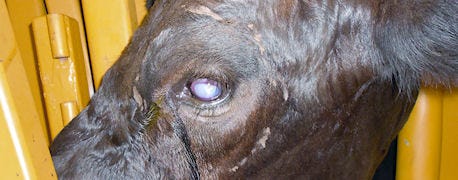November 19, 2013

Bob Bard thinks he may have figured how to use oxygen therapy on pinkeye in cattle.
Bard, who is a north Texas optometrist and beef producer, says when his cattle have developed pinkeye in recent years he's been using ozonated, distilled water, sprayed into the eye with a simple spray bottle several times over a day or two. He says usually the eye clears right up.

Texas optometrist uses ozonated, distilled water, sprayed into the eye to clear up pinkeye. (Photo courtesy Oklahoma State Veterinary College)
Oxygen therapy is not unusual for a variety of maladies, including eye problems, but it is not well known or possibly not well accepted across the medical community. It is sometimes used in hyperbaric conditions, meaning the patient is put in a pressurized chamber with higher-than normal oxygen content. Or the oxygen may be delivered straight into the airways for breathing, thereby increasing oxygen content in the blood.
Bard says he also knows of doctors and veterinarians putting an injured limb or appendage in a plastic bag and filling it with oxygen, then keeping the bag in place for about a half an hour, and repeating the process over several days.
He says about the time his cattle first started showing pinkeye seven or eight years ago, his wife also came down with the human version of the disease. A veterinarian friend had suggested using ozonated water on the cattle and Bard, who says he leans toward holistic medical practices, had already purchased a medical ozonater which converts medical grade oxygen to ozone. Bard says he put a few drops of ozonated water in his wife's eyes two nights in a row and cured her.
"When I treat people with antibiotics pinkeye never clears up that fast," he says with amazement.
The next time his cattle showed pinkeye he used the treatment on them and found the same rapid healing.
Bard and his wife have an extensive water filtration system which delivers water very similar to distilled water, so he suggests using distilled water for its cleanliness.
Bard was looking for an alternative to antibiotics for the occasional pinkeye problem in cattle when the ozonated water reared its head.
"I ozonate filtered water and put into a spray bottle and then just spray the affected eye. I have had tearing and mucus on a cow clear up and stop draining in 24 hours with just one spraying session. It never takes more than three or four sprayings to stop the infection without antibiotics," he says.
Incidentally, he still uses antibiotics in his paying medical patients.
Although Bard has a medical ozonator he suggests that any ozonator, such as those used to clean the water in hot tubs, could do the same work. He says internal treatment requires medical oxygen but for external treatment you can use oxygen from welding supply stores.
Bard suggests refrigerating the ozonated water to help stabilize it and suggests the quality of it probably doesn't last more than a few hours.
Bard says he also has used the ozonated water on cuts and infections on livestock and pets with some success and his veterinarian is using more conventional oxygen therapy on animals with great success.
How it works
It would appear since ozone is highly volatile in the lower atmosphere that ozonated water would create a dilute form of hydrogen peroxide (H2O2). Bard says they are not the same, however.
He once experimented with a few drops of food grade hydrogen peroxide in distilled water on a bull with pinkeye. He had his hired man administer the first treatment because Bard was busy and couldn't get there with ozonated water.
He says the diluted hydrogen peroxide appeared to slow down the infection but he did not fully trust the concoction and he finished the treatment with ozonated water, which appears to pose no dangers. Getting the hydrogen peroxide mixed to the right level is all guesswork, Bard says.
"You must use food grade H2O2 and not store bought because the store bought is not purified and has all kinds of metals and toxins," he says. "Store-bought is all right for cleaning cuts and scrapes but I would not use on eyes."
"Remember that store bought peroxide is about 3% and food grade is 35% H2O2," he adds.
You May Also Like




